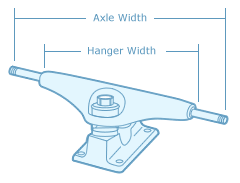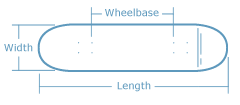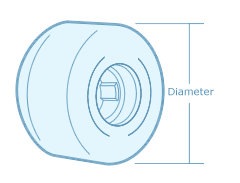
Given Skateboards
About Given Skateboards
Based out of Atlanta Georgia, Given was founded by pro skater Kris Markovich in the late 2000s. The skater owned and operated company is completely driven by Markovich’s design and artwork. Fixated on the Day of the Dead, Given boards feature extravagant hand-drawn pieces that represent the Dia De Los Muertos theme. Markovich is obsessed with this style because his style mirrors that of traditional Day of the Dead—beautifully imperfect with a tendency to look a little sloppy. If you’re looking for a skateboard that turns heads, Given doesn’t do it any better. You’ll also be pleased when it comes to this company’s commitment to durable gear. Constructed from traditional 7 ply maple, Given skateboard decks are built to last. They can easily withstand the toughest riding styles, so don’t be afraid to put all your strength into these boards! From skateparks to ditches, Given decks can take a beating from all types of terrains and never wear down. Their boards are easy for beginners to learn on and tenacious enough for more advanced riders to push them to the edge with technical tricks. Simply put, these boards have been tested by pros to ensure they can stand up to any riding style. Choose Given today and feel the difference in the way you ride!
With almost a decade in the skateboarding industry, Given has built a strong following that spreads from the East Coast to the West. You won’t be disappointed with what this brand has to offer!
Skateboard Decks Specs
- Deck width: 7.6" and larger
- Ages 13 years old and older
- Skater height 5'3" and taller
- Size 9 shoes or larger
Skateboard Completes Specs
- Deck width: 7.6" and larger
- Ages 13 years old and older
- Skater height 5'3" and taller
- Size 9 shoes or larger
Micro Decks Specs
- Deck width: 6.75" or smaller
- Ages 5 years old or younger
- Skater height 3'4" and under
- Size 3 shoes or smaller
Mini Decks Specs
- Deck width: 7.0"
- Ages 6 to 8 years old
- Skater height between 3'5" & 4'4" tall
- Size 4-6 shoes
Mid Decks Specs
- Deck width: 7.3" - 7.6"
- Ages 9 to 14 years old
- Skater height between 4'5" & 5'2" tall
- Size 7-8 shoes
Micro Completes Specs
- Deck width: 6.75" or smaller
- Ages 5 years old or younger
- Skater height 3'4" and under
- Size 3 shoes or smaller
Mini Completes Specs
- Deck width: 7.0"
- Ages 6 to 8 years old
- Skater height between 3'5" & 4'4" tall
- Size 4-6 shoes
Mid Completes Specs
- Deck width: 7.3" - 7.6"
- Ages 9 to 14 years old
- Skater height between 4'5" & 5'2" tall
- Size 7-8 shoes
Let Us Grip Tape Your Board
Don’t feel comfortable gripping up your new board? No need to worry. Avoid uneven lines and unwanted air bubbles by letting our professionals grip your new deck for you.
Let Us Build Your Skateboard
Do you want Warehouse Skateboards to Assemble your Complete Skateboard?
This service includes:
- Professionally gripping the skateboard deck. Insuring no bubbles and a nice clean cut around the edge.
- Pressing 8 skateboard bearings into 4 wheels. Each bearing will be seated with a professional bearing press and will include bearing spacers when necessary.
- Assembly of skateboard trucks and wheels. Both truck assemblies will have wheels installed with proper speed washers and torqued to the appropriate tolerance.
- Installing both truck assemblies to the gripped deck and assuring proper torque tolerance on all hardware.
- An autographed Warehouse Skateboards hang tag from your builder.
Skateboard Hardware Sets
Skateboard hardware is used to connect the skateboard trucks to the skateboard deck. Skateboard hardware refers to the bolts and locknuts used when building a board. The bolts can have an Allen or Phillips head. Skateboard hardware comes in many different lengths, and often includes one different colored bolt so that the rider can mark the nose of their board.
Each skateboard hardware set includes 8 bolts and 8 locknuts needed to assemble one skateboard.
What size hardware do I need to put together my skateboard?
- 7/8" to 1" hardware - no riser
- 1" to 1 1/8" hardware - 1/8" riser
- 1 1/4" hardware - 1/4" riser
- 1 1/2" hardware - 1/2" riser
The width of your truck axle should closely match the width of your skateboard deck, usually within 1/4”.

For additional info visit our
Skateboard Trucks Buying Guide
Truck height is measured from the bottom of the truck’s baseplate to the center of the axle. In general, a mid-sized truck works well for most skateboarders, but high or low trucks may be preferred for different styles of skaters.

LO - Provides extra stability for flip tricks, designed for small wheels (50-53mm wheel size recommended).
MID - Good all-around profile for street or park (53-56mm wheel size recommended).
HIGH - Great for cruising and carving, designed for large wheels (56mm+ wheel size recommended).
For additional info visit our
Skateboard Trucks Buying Guide
The hanger is the truck's T-shaped aluminum alloy grind area. It makes direct contact with rails and curbs. The hanger holds the axle on which the wheels are mounted. Hangers weigh about 10-13 oz, with lighter ones available. The width of your truck axle should closely match the width of your skateboard deck, usually within 1/4”.

For additional info visit our
Skateboard Trucks Buying Guide
Construction refers to the material(s) used in fabrication or the specific brand technology.
For additional info visit our
Skateboard Buying Guide
The average width of a skateboard deck is 7.5"- 8.25". Width is influenced by the size of the rider and the type of riding. Bigger riders and those skating ramps typically prefer a wider deck. Street skaters usually choose a smaller deck. Choose your skateboard deck according to the width, not length. Here are some general guidelines:

MICRO - Deck width: 6.75" or smaller - 5 years old or younger, under 3'4" tall. Size 3 shoes or smaller.
MINI - Deck width: 7.0" - 6 to 8 years old between 3'5" & 4'4" tall. Size 4-6 shoes.
MID - Deck width: 7.3" - 9 to 12 years old between 4'5" & 5'2" tall. Size 7-8 shoes.
FULL - Deck width: 7.5" or larger - for all skaters over age 13, taller than 5'3" with a shoe size of 9 or up.
7.5" to 8"
Standard board for adult riders skating streets or doing more technical tricks
8.0" to 8.25"
Skating pools, ramps and parks
8.25" and larger
Vert, pools, cruising and just going old school
Still having a hard time with size, try our Skateboard Sizer
For additional info visit our
Skateboard Decks Buying Guide
Deck type refers to the size or style (shape) of the skateboard deck. If you are a beginner, choose your deck according to the width, not the length. The width you need depends on your size, skating style and personal preference. Here are some general guidelines:

MICRO - Deck width: 6.75" or smaller - 5 years old or younger, under 3'4" tall. Size 3 shoes or smaller.
MINI - Deck width: 7.0" - 6 to 8 years old between 3'5" & 4'4" tall. Size 4-6 shoes.
MID - Deck width: 7.3" - 9 to 12 years old between 4'5" & 5'2" tall. Size 7-8 shoes.
FULL - Deck width: 7.5" or larger - for all skaters over age 13, taller than 5'3" with a shoe size of 9 or up.
Cruisers, Old School, Freestyle, Longboard and Downhill all refer to a skateboarding style and the corresponding shape.
For additional info visit our
Skateboard Decks Buying Guide
Length is measured from the tip of the nose to the tip of the tail. Average board length is 28"- 32" and longboards can range 32" and larger, but length is only referred to by advanced skaters.

For additional info visit our
Skateboard Decks Buying Guide
Wheel size or diameter - All Skateboard wheels are measured in millimeters (mm). The smaller the number, the smaller the wheel. Smaller wheels are slower; bigger wheels are faster.

50-53mm - Small slower wheels, stable for trick riding and smaller riders skating street, skate parks and bowls.
54-59mm - Average wheel size for beginners and bigger riders skating street, skate parks, bowls and vert ramps.
60mm + - Specialty riders skating longboards, old-school boards, downhill and dirt boards; made for speed and rougher surfaces.
For additional info visit our
Skateboard Wheels Buying Guide
Durometer measures the wheel’s hardness. Harder wheels are faster; softer wheels are slower but have better grip.
78a-87a - Soft wheel good for rough surfaces, longboards or street boards that need lots of grip and easier to roll over cracks and pebbles. Designed for a smooth ride cruising, longboards, hills and rough surfaces.
88a-95a - Slightly harder and faster with a little less grip, but the grip's still good. Street; rough surfaces.
96a-99a - Good speed and grip - an all-around wheel. Great for beginners skating street, skate parks, ramps and pools. Smooth surfaces.
101a + - Hardest and fastest wheel with the least grip. Ineffective on slick and rough surfaces. These are pro wheels.
83b-84b - Wheels using the B scale are extremely hard, measuring 20 points lower than the the A Scale in order to allow the scale to extend another 20 points for harder wheels.
For additional info visit our
Skateboard Wheels Buying Guide
The laws for skateboarding helmets vary from state to state. Many states require that skaters wear a helmet under a certain age, and some states like California make all skaters under 18 wear a CPSC Certified helmet at all times. CSPC skateboard helmets usually have an EPS protective liner that meets the safety standards for skateboarding. Make sure you check your state's regulations before ordering.
CPSC Certified Helmets: California requires that all skateboard helmets must meet the requirements of the United States Consumer Product Safety Commission (CPSC). Section 890.4 of the Streets and Highways Code enforces these standards in California and will not allow Warehouse Skateboards to ship non-CPSC Certified helmets to California.
For additional info visit our
Skateboard Helmets Guide
Unsure of the size you need?
Visit our Clothing Sizing Charts
Note: Each brands skateboard helmet size will vary; therefore, it is best to measure your head and refer to the sizing chart specific to each brand of helmet. In order to properly measure your head, follow these steps:
Wrap a soft tape measure around your forehead, just above your eyebrows and ears. Keep the tape measure level from the front to the back of your head. Your skateboard helmet should sit low on your forehead.

If you do not have a flexible tape measure, try marking a string and measuring it against a ruler.
If the helmet is a gift or you cannot measure the skater's head, measure the inside of a current helmet or hat they wear.
Within each skateboard helmet product page there are specific measurements for each skate brand. Use that information, along with your head size, to determine your correct helmet size before placing your order. This will ensure that you receive the best fit.
For additional info visit our
Sizing Skateboard Helmets